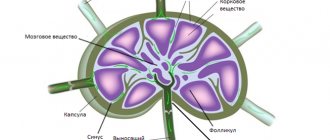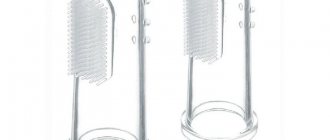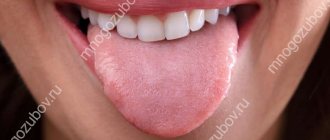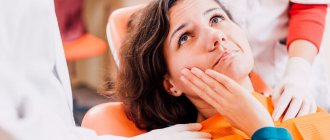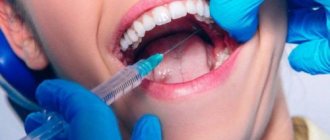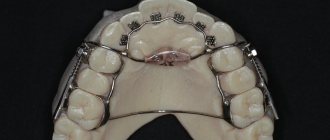General information
The organs of the lymphatic system play a protective role in the human body. They serve as a barrier to viruses, bacteria, and also filter out harmful substances. In total, there are more than 450 lymph nodes in the adult body, and their maximum number is formed by the age of 10.
Lymph nodes are connected by lymphatic vessels - lymph (a fluid with a high content of lymphocytes, or “white blood cells”) circulates through them. Produced in the bone marrow, lymphocytes circulate throughout the body, first passing through the spleen and then the lymph nodes. Thanks to this, they gain the ability to produce antibodies to destroy microbes. Source: A.G. Rumyantsev, professor, V.M. Chernov, professor, V.M. Delyagin, professor Enlarged lymph node syndrome as a pediatric problem Practical Medicine, 2007, No. 5 (24), pp. 12-15
When an infection enters , a kind of “attack” is carried out on it, as a result of which the lymph nodes can enlarge (during this period they more actively produce antibodies). After recovery, the nodes return to normal size. If their diameter and density do not return to their original state, the child must be shown to a doctor.
Lymphadenitis
Lymphadenitis is inflammation of the lymph nodes, sometimes purulent, of a specific and nonspecific nature.
Types and causes of lymphadenitis
Nonspecific lymphadenitis is usually caused by staphylococci or streptococci, other pathogens of purulent infection, as well as their decay products that have entered the lymph nodes. It can occur in both acute and chronic form. If the patient has purulent wounds, boils, trophic ulcers, dental caries and other local inflammations, regional lymphadenitis is observed. With extensive and general infections, this disease can be total. In children, lymphadenitis is most often provoked by tonsillitis, flu, otitis, as well as skin diseases - infected eczema, exudative diathesis, etc. Of a specific nature, this disease can be caused by pathogens of syphilis, plague, tuberculosis. In the human body, inflammation of the lymph nodes is most often localized in the armpit or groin area. In diseases of the ENT organs, the cervical, chin, and submandibular lymph nodes usually become inflamed. In this case, the cause of infection may be, for example, palatine tonsils or adenoids, influenza, tonsillitis, acute pharyngitis, or a viral infection caused by Epstein-Barr viruses or cytomegalovirus, etc. From infected organs by lymphogenous route, as well as with blood from other organs, infection enters the lymph nodes, which are the first barrier to infection.
Signs of lymphadenitis
The main signs that characterize this disease include local painful enlargement of the lymph nodes, which is externally noticeable, malaise, fever, headache, and weakness. Next, redness and swelling appear around the lymph nodes, their contours are already blurred, and any movements in that area of the body bring pain. As pus accumulates, its fluctuation in the lymph node is noted. Without surgical intervention, the abscess can not only break out, but also go deep into the tissue.
For cervical lymphadenitis
The cervical lymph nodes become denser and cause pain when pressed. Body temperature rises, headache, fluctuation in the area of the lymph nodes. In children, this type of disease proceeds faster and more unpleasantly - to the general symptoms there are added disturbances in sleep, appetite, swelling of the neck, and general malaise. If this process is started, sepsis may occur. Chronic cervical lymphadenitis is not so painful, but it is worth saying that the presence of this disease may indicate tuberculosis.
Submandibular lymphadenitis
It begins unnoticed - when pressing behind the ear and under the jaw there is a mild pain, this does not interfere with chewing and smiling at all. On the third day, a painful swelling and redness of the mucous membrane in the mouth usually appear under the jaw. If left untreated, the nagging pain will become stronger, and the skin of the face will begin to turn blue. In the chronic form, the symptoms are not very obvious - the lymph nodes enlarge, but practically painlessly.
Diagnosis of lymphadenitis
It is usually not difficult to recognize acute nonspecific lymphadenitis. The doctor takes into account the medical history and clinical manifestations. In the chronic course of the disease, a lymph node biopsy followed by histological analysis is necessary. Specific lymphadenitis caused by syphilis, tuberculosis, plague, etc. requires a whole range of clinical and laboratory tests. When diagnosing this type of lymphadenitis, venereologists, infectious disease specialists, and phthisiatricians are involved. It is not so difficult to identify the presence of lymphadenitis; it is much more difficult to find out its causes. Usually, when diagnosing this disease, a general blood test is needed, which will help identify and evaluate the presence of inflammatory processes in the body, and an ultrasound scan to assess the condition of the lymph nodes in an absolutely safe manner. If there is a suspicion of a tumor nature of enlarged lymph nodes, as well as chronic or specific lymphadenitis, in the absence of a positive effect from conservative treatment, a biopsy is performed. If lymph nodes located deep in the body are affected, an x-ray examination is necessary.
Treatment of lymphadenitis
During treatment, you may need to consult doctors of various specializations, depending on the location of the inflammation of the lymph nodes. For example, if you have problems in the submandibular and cervical areas, you need to contact an otolaryngologist or dentist. There are several directions in the treatment of lymphadenitis. Drug treatment involves eliminating the root cause of the disease, as well as symptomatic therapy. Physiotherapeutic methods used in the treatment of lymphadenitis include UHF, laser and galvanization. If complications of a purulent nature develop, surgical intervention is necessary. Its essence is that under local or general anesthesia, a purulent focus is opened, pus and affected tissue are removed.
In case of treatment of submandibular lymphadenitis
It should be taken into account that the source of infection is the oral cavity. So, first it is rehabilitated. Next, rinsing or compresses with special solutions are prescribed. Treatment can be supplemented with physiotherapy. Submandibular lymphadenitis in advanced form is treated with antibiotics. In the suppuration stage, surgical intervention is possible. It is important to know that submandibular lymphadenitis cannot be treated with folk remedies! A patient who has missed the time for effective professional treatment and relied on traditional methods can develop a disease that will then take on a chronic form.
Treatment of cervical lymphadenitis
in a mild form may include warmth, rest, avoidance of drafts, and drinking plenty of fluids. If a tuberculosis bacillus is detected, special antibiotics and hospital treatment are required. Diet is also important in the treatment of lymphadenitis. Fatty, carbohydrate-rich foods, dairy and flour products are prohibited.
Prevention of lymphadenitis
To avoid this disease, even the most innocent, at first glance, diseases should be treated in a timely manner. Avoid unnecessary scratches, injuries, and wounds. Visit your dentist regularly to keep your teeth and gums healthy.
Trust your health to the professionals of Preventive Medicine!
Indicators of normal lymph nodes:
- diameter up to approximately 5 mm;
- soft consistency;
- single location, that is, lack of connection with each other or with the skin;
- absence of pain upon palpation (palpation);
- mobility.
Reasons for enlargement and main groups of lymph nodes
| Group of lymph nodes | Typical reasons for the increase |
| Parotid | Pyoderma (inflammation of the scalp accompanied by pus), inflammation of the outer or middle ear, the presence of lice, atopic dermatitis, eczema. |
| Occipital | Various inflammations in the scalp, fungal diseases, rubella, etc. |
| Submental | Abscess of the jaw, inflammation of the lower lip, damage to the front teeth, stomatitis. |
| Submandibular | Gingivitis, stomatitis, dental damage. |
| Cervical (in the direction of the muscles at the back of the neck) | Sore throat, chronic tonsillitis, tuberculosis of the tonsils, adenoids, infectious form of mononucleosis. |
| Cervical (middle) | Scarlet fever, tonsillitis, “cat scratch disease”, Hodgkin or non-Hodgkin lymphoma ( important - these are malignant oncological processes!), toxoplasmosis. |
| Cervical (lateral) | Tumors, lymph node tuberculosis, nasopharyngeal infections. |
| Elbow | Infections of the forearm or hand. |
| Axillary | Shoulder or arm infections, vaccine reactions, cat scratch disease. |
| Inguinal | Infections of the skin, bones and muscles of the lower extremities, inflammation of the joints, dermatitis, inflammatory processes in the genitals, reaction to a vaccine introduced into the femoral area. |
Content:
- Causes of pathology
- Signs of inflammation of the submandibular lymph nodes 1.1. First stage 2.2. Second stage 2.3. Third stage
- How to cure an enlarged lymph node in the submandibular area
- Prevention of the inflammatory process
Inflammation of the submandibular lymph node is one of the most common types of lymphadenitis.
Its development is caused by inflammatory processes occurring in the oral cavity and less often in other parts of the body. Often the problem occurs with advanced caries, pulpitis, gingivitis, and inflammatory lesions of the tonsils. It is also caused by throat diseases. Let's take a closer look at why the submandibular lymph nodes are enlarged and what should be done to normalize the situation.
Oncological alertness
Lymph nodes are often enlarged due to lymphogranulomatosis (Hodgkin's lymphoma) or lymphosarcoma (non-Hodgkin's lymphoma). These are malignant processes that are manifested by increased density, painlessness and large diameter of the lymph nodes in the absence of other reasons for their deformation. Lymph nodes enlarge in groups, asymmetrically (for example, on one side of the neck). At the initial stage of the process, their mobility and separate arrangement are maintained. If the oncological process continues without treatment, the lymph nodes may become fused, and moderate pain rarely occurs. Source: N.V. Nagornaya, E.V. Vilchevskaya, A.P. Luachak, E.N. Marchenko, E.V. Bordyugova, A.P. Koval Hodgkin's disease (lymphogranulomatosis) in children // Child's Health, 2013, No. 1 (44), pp. 13-15
Symptoms that require consultation with a doctor are enlarged lymph nodes:
- more than 7 days;
- more than 1 group;
- accompanied by elevated body temperature;
- in a child under one year old;
- progressive over time;
- with changes in local skin.
Causes of pathology
If the lymph node changes its size, it can be assumed that a viral or bacteriological infection has spread. Taking into account the localization of the lesion, the doctor understands exactly where the source of the disease is located and which organs need urgent medical attention.
Among the dental provocateurs of enlarged submandibular lymph nodes:
- inflammation of the salivary glands;
- gingivitis;
- pulpitis;
- flux;
- stomatitis;
- alveolitis;
- periodontitis;
- deep caries;
- inflammation occurring under the crowns.
But the violation is not always associated specifically with dental diagnoses. Its reasons are:
- Respiratory diseases: pharyngitis, laryngitis, rhinitis.
- Pathologies related to the bone structures of the skull: damage to the bone structures of the lower jaw, damage to the temporomandibular joint, articular capsule.
- Infections: sore throat, measles, tonsillitis, otitis media, chicken pox, mumps. In all these cases, the lymphatic tissues swell a few days after the first symptoms of the disease appear.
- Specific pathologies caused by pathogenic pathogenic agents: toxoplasmosis, tuberculosis, syphilis, gonorrhea.
- Oncological neoplasms. Lymphatic tissue always reacts very sharply to tumor growth. Enlarged submandibular lymph nodes sometimes indicate the presence of a neoplasm in the area of the tongue, neck, or salivary glands.
- Autoimmune disorders. Always associated with disruptions in the functioning of the immune system. Then, by mistake, lymphocytes begin to treat healthy cells as dangerous pathogens. They destroy them, causing inflammation of the lymph nodes.
- Hyperthyroidism. With an exacerbation of this disease, the neck and cheek area swells, the lymph nodes become more voluminous.
In young children, parents may notice large round “balls” under the jaw during the period of active teething. This often causes an increase in body temperature. There is no need to be afraid of such symptoms. It is associated precisely with the inflammatory process provoked by the eruption of milk units. But, if the situation does not return to normal within three to five days, it is still worth showing the baby to a pediatric dentist, surgeon or pediatrician.
Diagnostic methods
After examination and collection of complaints and medical history, the specialist sends the child for a general examination . It includes x-rays, blood and urine tests . Additionally, the following studies may be needed:
- blood serology;
- diagnosis of tuberculosis;
- lymph node biopsy followed by cytological examination in the laboratory;
- Ultrasound.
Sometimes children are prescribed antibacterial drugs as part of the diagnosis. Based on their effectiveness, they confirm or refute the bacterial nature of the disease.
How to prevent lymphadenitis?
Few people want to experience the symptoms of lymphadenitis. And to prevent inflammation from attacking you, follow simple rules:
- Treat all oral diseases in a timely manner, to do this, contact your dentist once every six months (online appointment) for a preventive examination;
- avoid injuries and scratches in the jaw area;
- treat all wounds with antiseptics.
DaVinci Aesthetic Dentistry Studio will help cure lymphadenitis at any stage. But we would be even more happy to help you warn him.
Add a comment
Leave your comment
Treatment methods
Enlarged lymph nodes are not an independent disease, but a symptom of some other disease. Therefore, therapy in this case comes down to eliminating the root cause of this reaction. The rate at which nodes return to normal size varies, depending on the severity and type of underlying disease.
If a child gets sick very often, then immunomodulators are recommended to strengthen the body's defenses. The choice of drug should be made only by a doctor.
Important! Enlarged lymph nodes should not be heated - this can lead to the development of suppuration and blood poisoning! Any self-medication is prohibited - the reason and type of therapy is determined by a specialist.
Purulent tooth abscess and lymph nodes
A tooth abscess is a purulent inflammation that is localized inside the tooth after pulp removal, in the periodontal area or under the gum. This pathology is characterized by shooting, throbbing pains that intensify with pressure and heat on the tooth. Inflammation of the lymph nodes under the jaw is possible, which is sometimes even noticeable from the outside: the patient develops a slight swelling in the neck. In rare cases, the abscess spreads to the bone tissue and causes swelling on the face. Some complain of migraines. The disease is complicated by the presence of other dental diseases, such as caries.
Advantages of contacting SM-Clinic
“SM-Clinic” is a team of some of the best specialists in St. Petersburg, advanced diagnostic equipment and comfortable conditions. We have no queues, all examinations are carried out quickly, appointments are conducted by highly qualified doctors.
If your child has enlarged lymph nodes in the neck or in any other area, you should urgently contact a specialist for diagnosis and treatment. Delay in some cases is very dangerous!
To make an appointment with a pediatrician, immunologist or other pediatric specialist, call us.
Sources:
- A.G. Rumyantsev, professor, V.M. Chernov, professor, V.M. Delyagin, professor. Syndrome of enlarged lymph nodes as a pediatric problem // Practical Medicine, 2007, No. 5 (24), pp. 12-15.
- N.V. Nagornaya, E.V. Vilchevskaya, A.P. Luachak, E.N. Marchenko, E.V. Bordyugova, A.P. Koval. Hodgkin's disease (lymphogranulomatosis) in children // Child's Health, 2013, No. 1 (44), pp. 13-15.
Grek Elena Anatolyevna Clinic
Author of the article
Grek Elena Anatolyevna
Doctor of the highest qualification category
Specialty: immunologist
Experience: 23 years
The information in this article is provided for reference purposes and does not replace advice from a qualified professional. Don't self-medicate! At the first signs of illness, you should consult a doctor.
How to cure an enlarged lymph node in the submandibular area
Therapy must be carried out under medical supervision. Its main goal is to eliminate the infection that caused the disorder. If the root cause of the condition is not established, it will not be possible to be completely cured.
If the problem is related to an oral disease, mandatory treatment is carried out. For severe inflammatory pathologies of internal organs, antibiotic therapy is carried out. For pathologies of a viral nature, patients are prescribed antiviral drugs.
If the examination reveals that pus has accumulated inside the tissues, it is drained using a drainage tube. Additionally, a puncture is taken to recognize the pathogen and understand whether the disease has a benign or malignant course.
As soon as the infectious focus disappears, the lymph nodes begin to shrink, stop hurting and gradually reach their normal state.
Prices
| Name of service (price list incomplete) | Price |
| Appointment (examination, consultation) with an allergist-immunologist, primary, therapeutic and diagnostic, outpatient | 1750 rub. |
| Consultation (interpretation) with analyzes from third parties | 2250 rub. |
| Prescription of treatment regimen (for up to 1 month) | 1800 rub. |
| Prescription of treatment regimen (for a period of 1 month) | 2700 rub. |
| Consultation with a candidate of medical sciences | 2500 rub. |
| Allergen-specific immunotherapy (ASIT) - maintenance course (excluding the cost of the drug) | 8100 rub. |
The main directions of treatment of submandibular lymphadenitis
The direction of treatment is determined by the etiology of the inflammatory process. If the disease is infectious, antibiotics, antifungal and anti-inflammatory drugs, sprays and ointments are prescribed. Purulent inflammations are treated promptly under local anesthesia. The doctor cleans the lymph node of purulent masses and installs drainage. After this, the patient is prescribed appropriate medications.
Often, after eliminating the underlying pathology that led to inflammation of the lymph nodes, all its symptoms, including lymphadenitis, disappear. If this does not happen, the patient undergoes a course of physical therapy. Immune-boosting therapy may be needed. The patient needs to stop smoking, start eating right and taking vitamins.
